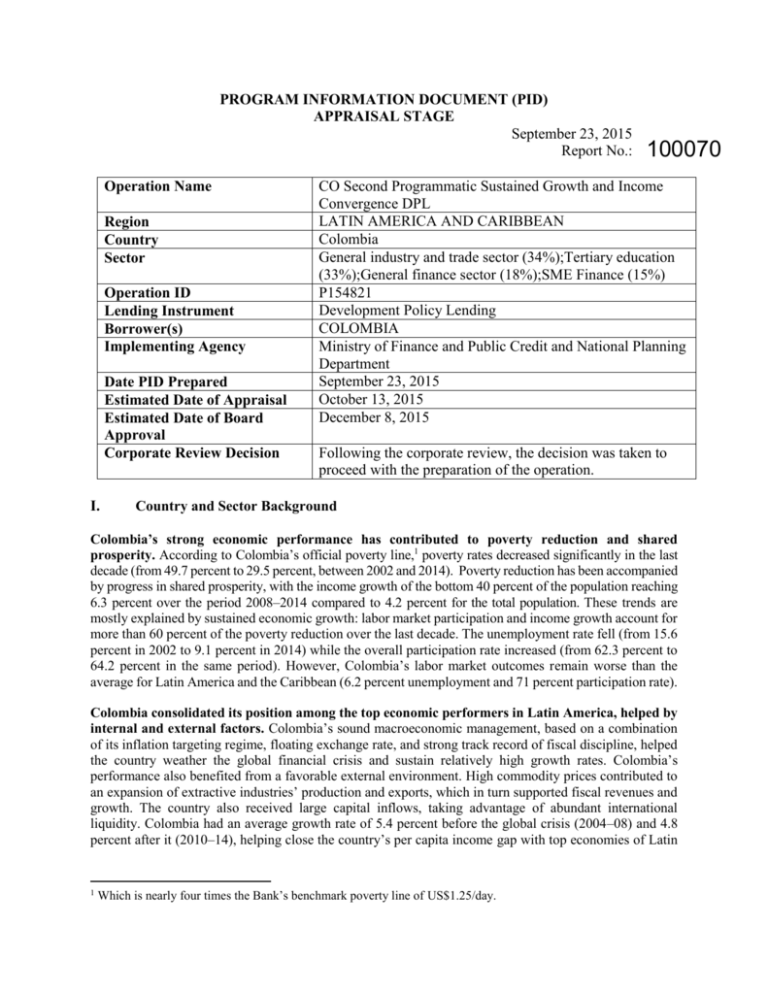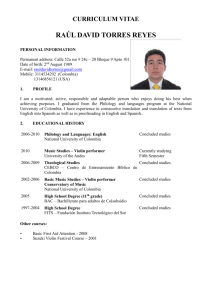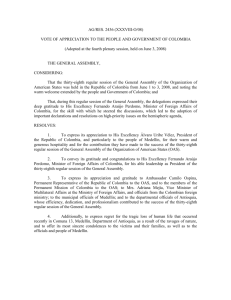Program Information Document - Documents & Reports
advertisement

PROGRAM INFORMATION DOCUMENT (PID) APPRAISAL STAGE September 23, 2015 Report No.: Operation Name Region Country Sector Operation ID Lending Instrument Borrower(s) Implementing Agency Date PID Prepared Estimated Date of Appraisal Estimated Date of Board Approval Corporate Review Decision I. 100070 CO Second Programmatic Sustained Growth and Income Convergence DPL LATIN AMERICA AND CARIBBEAN Colombia General industry and trade sector (34%);Tertiary education (33%);General finance sector (18%);SME Finance (15%) P154821 Development Policy Lending COLOMBIA Ministry of Finance and Public Credit and National Planning Department September 23, 2015 October 13, 2015 December 8, 2015 Following the corporate review, the decision was taken to proceed with the preparation of the operation. Country and Sector Background Colombia’s strong economic performance has contributed to poverty reduction and shared prosperity. According to Colombia’s official poverty line,1 poverty rates decreased significantly in the last decade (from 49.7 percent to 29.5 percent, between 2002 and 2014). Poverty reduction has been accompanied by progress in shared prosperity, with the income growth of the bottom 40 percent of the population reaching 6.3 percent over the period 2008–2014 compared to 4.2 percent for the total population. These trends are mostly explained by sustained economic growth: labor market participation and income growth account for more than 60 percent of the poverty reduction over the last decade. The unemployment rate fell (from 15.6 percent in 2002 to 9.1 percent in 2014) while the overall participation rate increased (from 62.3 percent to 64.2 percent in the same period). However, Colombia’s labor market outcomes remain worse than the average for Latin America and the Caribbean (6.2 percent unemployment and 71 percent participation rate). Colombia consolidated its position among the top economic performers in Latin America, helped by internal and external factors. Colombia’s sound macroeconomic management, based on a combination of its inflation targeting regime, floating exchange rate, and strong track record of fiscal discipline, helped the country weather the global financial crisis and sustain relatively high growth rates. Colombia’s performance also benefited from a favorable external environment. High commodity prices contributed to an expansion of extractive industries’ production and exports, which in turn supported fiscal revenues and growth. The country also received large capital inflows, taking advantage of abundant international liquidity. Colombia had an average growth rate of 5.4 percent before the global crisis (2004–08) and 4.8 percent after it (2010–14), helping close the country’s per capita income gap with top economies of Latin 1 Which is nearly four times the Bank’s benchmark poverty line of US$1.25/day. America and high-income countries of the Organization for Economic Co-operation and Development (OECD). However, growth has been slowing in the context of a less favorable external environment. Colombia is currently facing headwinds and growth will have to come from unlocking existing structural bottlenecks. External conditions have deteriorated significantly over the last 12 months. International oil prices have declined sharply (56 percent since mid-2014), leading to a deterioration in the terms of trade (25 percent since mid-2014). Expectations about monetary policy changes in the United States has been leading to lower and more volatile capital flows. In this context, sustaining economic growth will depend even more on Colombian firms’ ability to efficiently produce and sell goods and services. Therefore, addressing structural bottlenecks can yield important growth dividends. In particular, closing Colombia’s gap with top performers in Latin America and OECD with respect to physical capital, labor, and human capital quality, as well as productivity, particularly through innovation and a regulatory environment for businesses, will be critical. In addition, Colombia faces a number of structural bottlenecks limiting Colombia’s long term growth performance. Bottlenecks include financial markets development (in particular financing for investment in infrastructure and physical capital by firms), low levels of human capital and skill mismatches, limited innovation, restrictive business and labor regulations, limited international trade, and impacts of the armed conflict.2 In most of these areas, Colombia presents a significant performance gap with respect to top LAC economies and OECD countries. Addressing those gaps is critical to sustain high growth rates, continue social gains and speed up convergence in standards of living. II. Operation Objectives The Programmatic Sustained Growth and Income Convergence Development Policy Series contributes to Colombia’s growth and convergence agenda by supporting the implementation of policy reforms in three main areas: (i) fostering solutions to develop infrastructure financing and increasing access to finance for firms; (ii) improving the quality and allocation of productive skills; and (iii) promoting innovation and an efficient regulatory environment. This Second Programmatic Sustained Growth and Income Convergence Development Policy Loan (DPL) continues to support the Colombian government’s efforts to sustain economic growth and increase productivity. This DPL for US$700 million is the last in a series of two single tranche operations. It comes in the context of lower export demand for commodities, worsening terms of trade, and the prospects of higher borrowing costs that are affecting a large number of emerging economies. The DPL series seeks to address selected bottlenecks to spur productivity across sectors, which will be critical for growth amid the less favorable external environment. The supported program is fully consistent with the FY12–FY16 Colombia Country Partnership Strategy (CPS), particularly the pillar on inclusive growth with enhanced productivity; and with the government’s National Development Plan (NDP) for 2014–2018, in its strategic area of infrastructure and competitiveness and the pillar of education. 2 OECD Colombia Economic Survey (2013) PRIOR ACTIONS UNDER DPL2 Pillar 1-- Fostering solutions to develop infrastructure financing and increasing access to finance for firms Prior Action #1: In order to promote the financing of projects under the 4G Program, the GoC has i) reduced restrictions for pension funds to invest in private capital infrastructure funds and ii) relaxed the requirements for funding operations in international markets (Decree No. 1385, June 22, 2015; and Resolution No.4, April 24, 2015) Prior Action #2: In order to promote the financing of projects under the 4G Program, the GoC has i) reduced restrictions for pension funds to invest in private capital infrastructure funds and ii) relaxed the requirements for funding operations in international markets (Decree No. 1385, June 22, 2015; and Resolution No.4, April 24, 2015) Prior Action #3: The GoC, through the SFC, has issued guidelines establishing the new governing rules for the management of mutual funds (Fondos de Inversion Colectiva); and has set internal policies, procedures and operating systems for the new activity of custody of securities (Circular Externa 015 de 2014; Circular 026, September 15, 2014 – SFC; Circular 031, November 21, 2014; Circular Externa No. 005 de 2015) Pillar 2-- Improving the quality and allocation of productive skills Prior Action #4: The GoC has strengthened the PES system by defining the institutional arrangements, responsibilities and information requirements for the implementation of the PES management and job placement tools. (Resolution 1397 of April 27, 2015, Resolution 129 of March 4, 2015) (Resolution 3418 of 14 August 2014) (Resolution 2605 June 25, 2014) Prior Action #5: The GoC has improved the development of professional skills by: (i) creating the national framework of professional qualifications and competencies, (ii) establishing a system of transfers and credits connecting the different branches of tertiary education, and (iii) defining the Ministry of Education as responsible for implementing this system. (Article 58 PND Law, May 2015) Prior Action #6: The GoC has created a special regime for indigenous territories, including an indigenous educational system, and in particular a system of tertiary education for indigenous communities. (Decree 1953, of October 7, 2014) Pillar 3 - Promoting innovation and an efficient regulatory environment Prior Action #7: The GoC has improved the effectiveness of public investment in innovation by: (i) defining the criteria for formulation, selection and approval of innovation projects financed with royalties’ resources, and (ii) creating an information platform to monitor projects financed by royalties (MAPAREGALIAS). (Article 07, NDP Law, May 2015; and Agreements 0023, June 26, 2014 and Agreement 0027, April 15, 2015 from DNP) Prior Action #8: The GoC has strengthened the system of tax benefits for innovation by defining the specific eligible expenses that could be granted as fiscal benefits, including firm-led innovation. (CONPES 3834, July 2015 Prior Action #9: In order to improve the coordination and allocation of resources for productive development, the GoC has unified the Governance System of Competitiveness and Innovation with the Governance System for Science Technology and Innovation at national and regional levels (Article 186, PND Law, May 26 2015) Prior Action #10: In order to prevent new regulations from interfering with competitive practices, the GoC has established procedures for the drafting of regulations, in line with OECD best practices (Decree 1609, August 10 2015) Prior Action #11: In order to facilitate international trade the GoC has: i) regulated Authorized Economic Operators, eligible to streamlined broader procedures ; and ii) implemented an integrated transit of goods (TIM) with Ecuador. (Decree 1894, September 22 2015; Circular 22/DIAN, May 28, 2015) III. Rationale for Bank Involvement The DPL series is fully aligned with the FY12-FY16 Country Partnership Strategy (CPS) (CPS) (discussed in July 2011) and with the CPS Progress Report (discussed in May 2014). In particular, the series contributes to the strategic Pillar 1, ‘Expanding Opportunities for Social Prosperity’ and Pillar 3, ‘Inclusive Growth and Enhanced Productivity’. Specifically, it supports the development objectives of (a) improving coverage and monitoring of select social services, in particular for the poor; (b) increasing education for students from disadvantaged households; and (c) improving instruments to mobilize capital. This DPL also complements the Bank’s long-term partnership with the GoC to support the country’s development and contributes to the WB twin goals of reduced poverty and shared prosperity. This DPL has been supported by the technical work developed under different thematic Programmatic Approach (PA) for Colombia, including the Sound Financial Sector Development PA, the Innovation and Competitiveness PA and the Public Sector PA. In addition, the definition of the PDO and the overall diagnostic that supported the design of the operation were based on the work under the Strengthening Fiscal Policy for Sustained and Inclusive Growth PA and the Colombia Policy Notes. Finally, it is worth highlighting that this DPL series follows a long engagement with Colombia through DPLs, including the Fiscal Sustainability and Growth Resilience DPL I (2011) and II (2012) and the Fiscal Policy for Shared Prosperity DPL (2013) and the DPL series on business productivity and efficiency implemented between 2006 and 2011. IV. Tentative financing Source: Borrower International Bank for Reconstruction and Development Borrower/Recipient IBRD Others (specify) ($m.) 0 700 Total V. 700 Tranches (if applicable) ($m.) First Tranche Second Tranche Etc. Total VI. Institutional and Implementation Arrangements The preparation of this operation is being led by the Ministry of Finance and the National Planning Department, with participation from the Ministry of Education, Ministry of Labor, Ministry of Commerce, DIAN, COLCIENCIAS and SENA. The MHCP and DNP are responsible for coordinating actions among the concerned agencies. The MHCP’s Department for Public Credit will collect the necessary data to assess the implementation progress for which the MHCP is responsible (including Pillar 1 and Pillar 3 - trade facilitation) and report it to the Bank. Similarly, the DNP will collect and report to the Bank the information related to the implementation progress of the program (Pillar 2 and Pillar 3 promoting innovation and technological progress and improving regulatory efficiency). Finally, the DANE will be responsible for online release of national accounts, household survey micro-data for replicating poverty, and other social indicators. The Program outcomes will be monitored through the measurement of the indicators included in the policy matrix. The indicators seek to assess progress towards the implementation of the reforms supported by the proposed DPL and will be evaluated one year following the disbursement of the Loan. VII. Risks and Risk Mitigation The overall risk for this operation is moderate. This DPL is subject to risks related to a deteriorating external economic environment, possible changes in government, and delays in reform program implementation. Despite solid fundamentals, Colombia’s near-term macroeconomic outlook could be adversely affected by deeper external shocks. This risk is mitigated by the country’s high policy response capacity. In addition, the government has made important regulatory changes to help mitigate risks associated with implementing the reform program, but delays may happen given the natural transition process of the new administration. VIII. Poverty and Social Impacts and Environment Aspects Poverty and Social Impacts The government policies supported in this operation are expected to have a positive poverty and social impact. The actions supported by this operation that are intended to increase growth and productivity are likely to have similar impacts on poverty reduction and shared prosperity as those supported by the first DPL. The Poverty and Social Impact Assessment (PSIA) has been carried out, documenting these expected impacts from a social, gender, and distributional perspective. This assessment, explained in more detail in annex 5, presents the potential outcomes of the policy actions on overall growth, employment, and welfare of the poor and those in the bottom 40 percent of the income distribution. The PSIA is organized around the policy pillars outlined in this DPL2. In particular, in Pillar 1, the policies that strengthen infrastructure financing and increase access to credit for firms are expected to have positive effects on employment (and formalization), reduce transport and logistic costs, increase engagement of the poor in entrepreneurial activities, and therefore contribute to the growth of the incomes of those in the bottom 40 percent of the income distribution. With respect to Pillar 2, the strengthening of the system for matching workers and vacancies is expected to increase the employability of the bottom 40 percent, as these groups rely more on their own informal networks to find employment. In addition, strengthening the professional training system targeted to the unemployed is expected to increase the probability of employment for the poorest. Moreover, the creation of a special regime for indigenous territories that transfers resources for human capital formation to indigenous communities could increase access to general education and productive skills for these populations while preserving cultural traces and norms. Within Pillar 3, a better allocation of resources to fit regional priorities and a better information platform to monitor financing from royalties are expected to affect the efficiency of spending of limited public resources. A proper implementation of incentives for R&D may potentially enhance growth, but the direct effects on poverty and inequality reduction are ambiguous. Finally, trade facilitation has positive indirect effects on poverty and shared prosperity and may contribute to economic growth. Environment Aspects The proposed operation is not likely to have significant effects on the environment, forests, and other natural resources, but there is a small risk of potential indirect effects. This DPL supports actions that will lead to more efficient financing for the 4G program, that is, for a number of selected transport infrastructure investment projects. These are purely regulatory measures without a direct link to physical infrastructure. Nevertheless, that program faces a small risk of potential indirect environmental impacts, which is mitigated by Colombia’s national environmental regulations (applicable to the program). Colombia has a system of environmental licensing dating back to the 1974 Code on Renewable Natural Resources and Environmental Protection. The requirement to carry out environmental assessments for projects with possible environmental impacts, in its current form in Colombia, is regulated by Law 99, adopted in 1993, and a series of subsequent modifications. As stipulated by the law, the Ministry of Environment and Sustainable Development, the regional environmental authorities, and municipalities, depending on the nature of the works, are responsible for issuing environmental licenses. In the case of the 4G program, which is centrally implemented and monitored, there additional protection and due diligence to the national environmental regulations. The government approved a 4G CONPES that sets guidelines for the allocation of environmental risks (particularly the responsibility for obtaining and managing environmental licenses) in the new pipeline of road concessions. IX. Contact point World Bank Contact: Barbara Cunha Title: Senior Economist Tel: (202) 473-0572 Fax: Email: bcunha@worldbank.org Contact: Patricia Caraballo Title: Financial Sector Specialist Tel: (202) 458-5583 Fax: Email: pcaraballo@worldbank.org Borrower Contact: Lina Maria Mondragon Artunduaga Title: Subdirector Técnico de Financiamiento con Organismos Multilaterales y GobiernosMinisterio de Hacienda y Crédito Público Tel: (57 1) 381 1700 Ext. 2196 Email: lmondrag@minhacienda.gov.co X. For more information contact: The InfoShop The World Bank 1818 H Street, NW Washington, D.C. 20433 Telephone: (202) 458-4500 Fax: (202) 522-1500 Web: http://www.worldbank.org/infoshop



